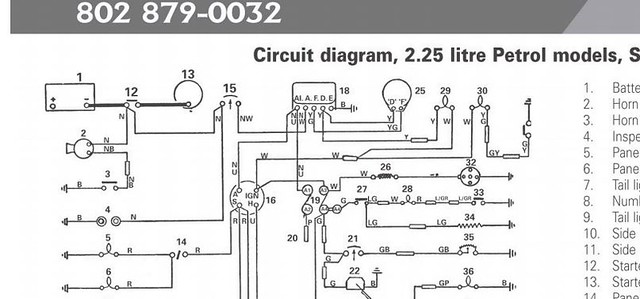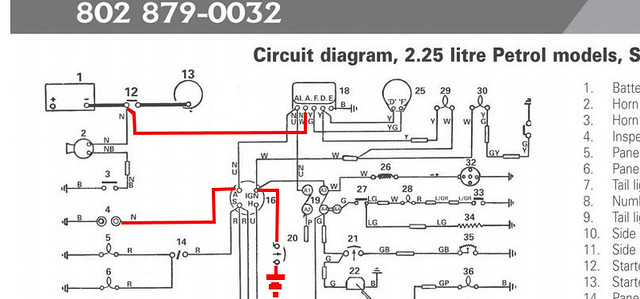Is the wiring the same? This is on a neg earth 61 109 station wagon with a Delco three wire alternator. Thanks.
Removing ammeter and replacing with volt meter.
Collapse
X
-
No.
ALL the un-fused electricity flows through the ammeter before moving on to the vehicle's power distribution system. The ammeter measures this flow. The ammeter is in integral part of the power supply circuit. Without it, no electricity will flow to the rest of the electrical system unless you connect the 2 ammeter wires together.
A voltmeter simply probes the amount of voltage available between a certain spot in the vehicle's electrical circuit and ground.
If it were me, after disconnecting the battery, I'd remove the wire going from the battery side of the starter switch to the ammeter, then connect the fat wire that runs between the voltage regulator and the ammeter directly to the battery side of the starter switch, and re-wire the test probe (the red socket in the dash panel) so that instead of drawing it's power from the now-disabled ammeter, it draws it from some other source, like the always-hot terminal of the ignition switch (Terminal "A" according to the schematic).
To install a voltmeter, I'd simply wire the red lead to the IGN terminal of the ignition switch and the black lead to the black test socket terminal.--Mark
1973 SIII 109 RHD 2.5NA Diesel
0-54mph in just under 11.5 minutes
(9.7 minutes now that she's a 3-door). -
Thank you. I forgot to mention that I'm doing a frame off refurbishment on this truck. All the electricals will be redone from scratch with all new wiring. I'd like to incorporate a modern fuse box, and use relays for some circuits. Does that change anything.Doug
61 Series II 109 SW
95 RR County LWB
06 Range Rover
98 Discovery LEComment
-
Simply put, the ammeter is wired in series, the voltage gauge is wired in parallel. IMHO, it's just smart and safe to ditch the ammeter. If it goes, it cuts off the power to everything down stream, which is pretty much everything. If a voltage gauge goes, it doesn't affect the function of anything else.
The typical series rover ammeter toasted pretty quick and in exciting fashion when overloaded......Jason
"Clubs are for Chumps" Club presidentComment
-
Oops--forgot the test probe is ALWAYS hot. Don't want the volt meter draining your battery! I've changed the original post so that you wire the voltmeter into a circuit that is only hot with the ignition switch in the "run" position.
So in all it goes FROM this...:

...TO this:

If you wanted the voltmeter to be in a fused circuit, you could connect the voltmeter wire to the terminal marked A4 in the schematic instead of the IGN terminal on the ignition switch.--Mark
1973 SIII 109 RHD 2.5NA Diesel
0-54mph in just under 11.5 minutes
(9.7 minutes now that she's a 3-door).Comment
-
Oh, and if you're upgrading to a Delco alternator you'll have to ditch the ammeter anyway. The delco can put out enough amps to fry the little factory ammeter if you have a bunch of electrical equipment going all at once.
If you're starting from scratch, you have a clean slate and you can do anything you want. I wouldn't recommend following the old schematic too much. Here's one I drew up of a fully-fused harness with a delco 1-wire alternator (with provisions for a 3 wire alternator if you like the charge lamp to function) along with 2 auxilary wires to the front and 2 aux wires to the rear and one just to the engine bay (in case you want to add more lights up front or in the rear or whatever):
 --Mark
--Mark
1973 SIII 109 RHD 2.5NA Diesel
0-54mph in just under 11.5 minutes
(9.7 minutes now that she's a 3-door).Comment
-
Wow! Thank you for all that info. That will really help me out as I am an auto electrics novice at best.Oh, and if you're upgrading to a Delco alternator you'll have to ditch the ammeter anyway. The delco can put out enough amps to fry the little factory ammeter if you have a bunch of electrical equipment going all at once.
If you're starting from scratch, you have a clean slate and you can do anything you want. I wouldn't recommend following the old schematic too much. Here's one I drew up of a fully-fused harness with a delco 1-wire alternator (with provisions for a 3 wire alternator if you like the charge lamp to function) along with 2 auxilary wires to the front and 2 aux wires to the rear and one just to the engine bay (in case you want to add more lights up front or in the rear or whatever):
 Doug
Doug
61 Series II 109 SW
95 RR County LWB
06 Range Rover
98 Discovery LEComment
-
This may come out as if I'm being an anus, but with that question, you've just revealed that you have no idea what you're doing! I would stop here, do a little reading up on how an alternator, and specifically a Delco type alternator works. For the record, the Delco has an internal voltage regulator, so the big fat Lucas thing on the bulkhead is of no use to you. Not trying to be a d**k, sorry if it comes off that way.
An ammeter is simply a gauge to tell you how much juice is flowing. In most cases we really don't give a hoot. For battery condition monitoring a digital voltmeter is the best gauge. An ammeter WILL tell you if your genny is working, but since you don't have one any more it's moot. You may safely bypass the amp meter (and a 30 amp swing is kinda dopey in this age of 150 plus amp alternators). If you do buy a volt meter, don't waste money on one that has big chunky numbers and a fat needle. They're useless. The difference between a dead flat battery and a live one is about .5V, so unless your voltmeter can tell you for certain the exact voltage, you're shooting in the dark. An amp meter that can cover the range of the alternator would also be a good thing to have. This will tell you if the draw on the battery is being replenished sufficiently by the alternator.Comment
-
He's already been very honest and upfront about being an auto electrics novice.Jason
"Clubs are for Chumps" Club presidentComment
-
You are right on both accounts. I'm trying to figure things out though, and am doing my homework. That is why I posted on here, to get some help.Doug
61 Series II 109 SW
95 RR County LWB
06 Range Rover
98 Discovery LEComment
-
Doug
61 Series II 109 SW
95 RR County LWB
06 Range Rover
98 Discovery LEComment
-
Oh...Just in case anyone ever models their own custom harness off the schematic I posted in post #7 of this thread...
One thing to note is that there is no voltage stabilizer or temp gauge depicted--There are provisions for a temp sender and gauge, but the rover this harness was meant for doesn't have one nor does it use a stabilizer for the fuel gauge. Easy stuff to slip in to the plan, though.--Mark
1973 SIII 109 RHD 2.5NA Diesel
0-54mph in just under 11.5 minutes
(9.7 minutes now that she's a 3-door).Comment

Comment